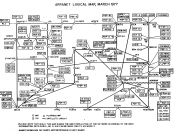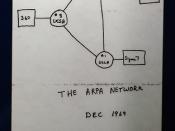The idea of the Internet first came to be in the year 1957 when the USSR launched Sputnik, the first artificial earth satellite. In response to this, the United States formed the Advanced Research Projects Agency (ARPA) within the Department of Defense to establish US lead in science and technology applicable to the military. Five years later Paul Baran is commissioned by the United States Air Force to do a study on how it could maintain control over its missiles and bombers in the event of a nuclear attack. His final proposal was a packet switched network.
In 1968 ARPA awarded the ARPANET contract to BNN, the physical network was constructed in 1969 connecting four nodes: University of California at Los Angeles, SRI, University of California at Santa Barbara, and University of Utah. The network was wired together via 50 Kbps circuits. Three years later the first email program was created by Ray Tomlinson of BBN and the Advanced Research Projects Agency was changed to The Defense Advanced Research Projects Agency. ARPANET was currently using the Network Control Protocol to transfer data. This allowed communications between hosts running on the same network.
In 1973 development began on the protocol later to be called TCP/IP, it was developed by a group headed by Vinton Cerf from Stanford and Bob Kahn from DARPA. This new protocol was to allow diverse computer networks to interconnect and communicate with each other. One year later in 1974 Vint Cerf and Bob Kahn wrote a paper on Transmission Control Protocol and land marked the term The Internet.
On January 1st 1983, every machine connected to ARPANET had to use TCP/IP. TCP/IP became the core Internet protocol and replaced NCP entirely. Later in 1983, the University of Wisconsin created Domain Name System (DNS). This allowed packets...


